A Customer’s Perspective on Making Enterprise Linux Deployable, Scalable and Manageable Kevin Masaryk Linux/UNIX Administration Salt River Project Christopher Wells Senior Product Marketing Manager Red Hat Shawn Wells Global System z Platform Manager Red Hat
Slide 1

Slide 2

Agenda l Management Challenges facing IT Organizations l Red Hat Satellite Overview l Salt River Project Satellite Implementation l
Overview
Key Features That Brought Value
Lessons Learned Question and Answer 2
Slide 3
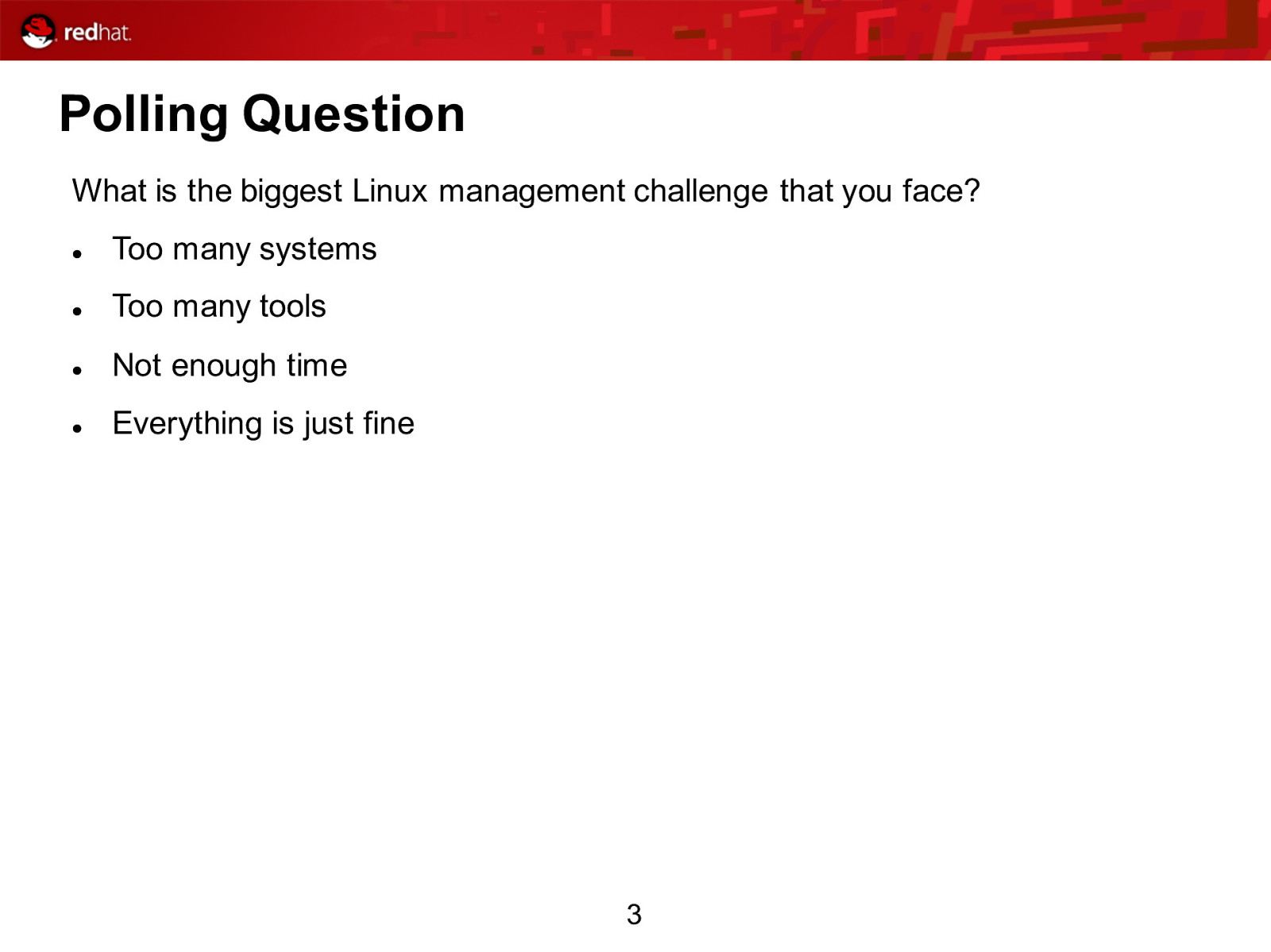
Polling Question What is the biggest Linux management challenge that you face? l Too many systems l Too many tools l Not enough time l Everything is just fine 3
Slide 4

Are you facing these challenges? l l l l l l l Manually managing (obtain, track, organize and apply) systems updates on a system by system basis? Managing custom content updates? Rolling back configuration problems based on any changes that were made? Tracking configuration changes made to systems for auditing purposes? Excessive downtime caused by manual configurations that are excessively error prone and lengthy? Efficiently provision and re-provision virtual and bare-metal systems? Unnecessary downtime caused by lack of visibility into system performance? 4
Slide 5

Bottom line l l The time and cost to manually manage the Linux environment grows exponentially as the number of Linux deployments increases How can you reduce management costs, unnecessary downtime and better leverage your Linux environment? 5
Slide 6

Polling Question How do you manage your Linux Environment? l Use a combination of Open Source tools like yum and cobbler with scripts l Red Hat Network Hosted l Other Third-party management tools l Don’t Manage/Don’t Know 6
Slide 7
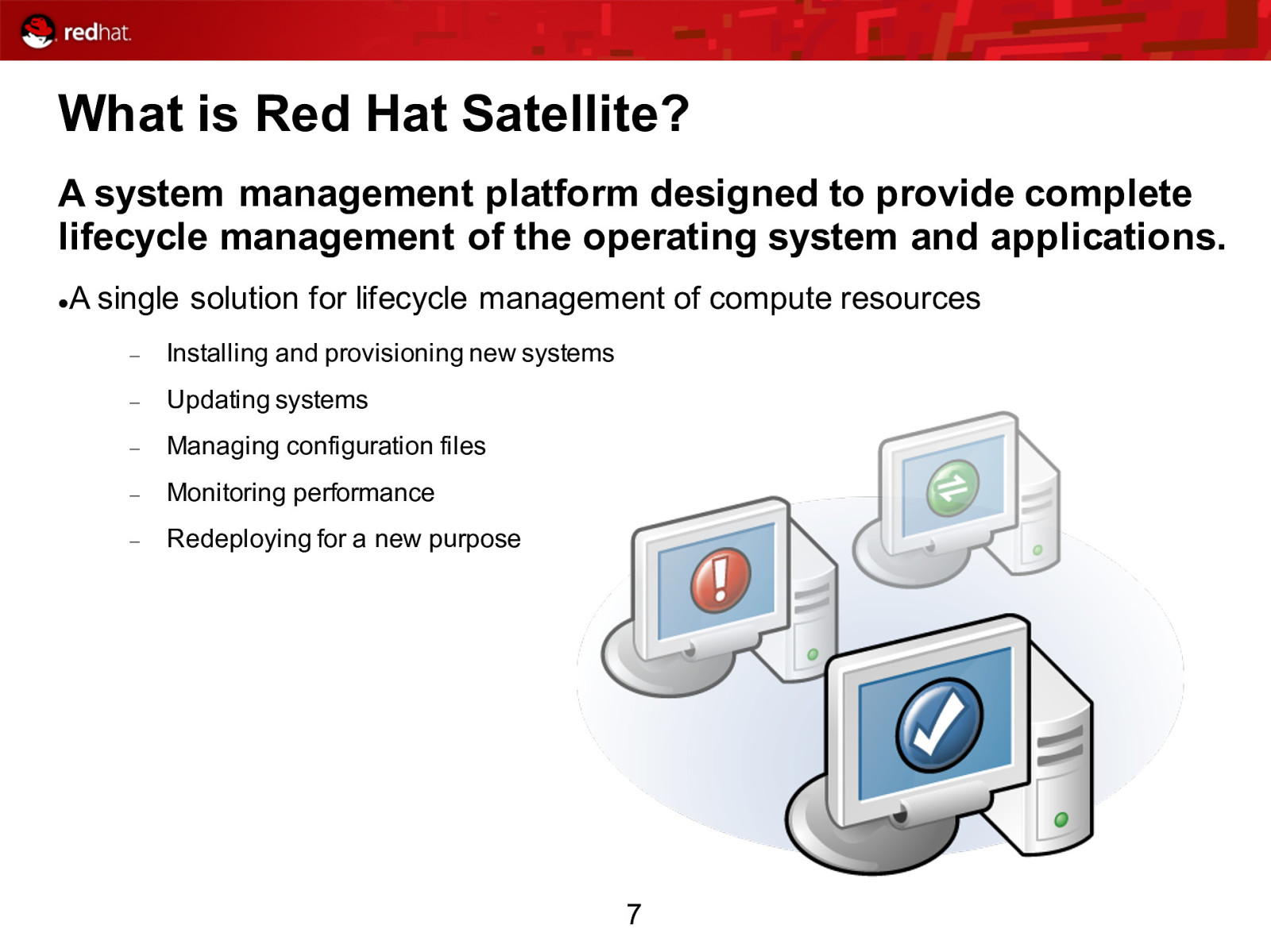
What is Red Hat Satellite? A system management platform designed to provide complete lifecycle management of the operating system and applications. l A single solution for lifecycle management of compute resources - Installing and provisioning new systems
Updating systems
Managing configuration files
Monitoring performance
Redeploying for a new purpose 7
Slide 8

Red Hat Network Hosted Customer Systems RHN Hosted l System Management l Software Distribution l Account Management l Subscription Management WEB INTERFACE MANAGED SYSTEMS l l l Quick setup is designed for rapid and efficient management for small deployments All system information, profiles, and packages are stored in Red Hat’s servers Each managed system connects across the Internet for all managed actions 8
Slide 9

Red Hat Satellite RHN Hosted l Software Distribution l Subscription Management RHN Satellite • Software Distribution • Account Management • Channel Management • Monitoring • Provisioning WEB INTERFACE RHN Proxy API LAYER MANAGED SYSTEMS IT Applications Custom Content l Enterprise management solution – enhanced control l Synchronizes content with RHN Hosted, another Satellite, or physical media l Custom content distribution 9
Slide 10

Slide 11
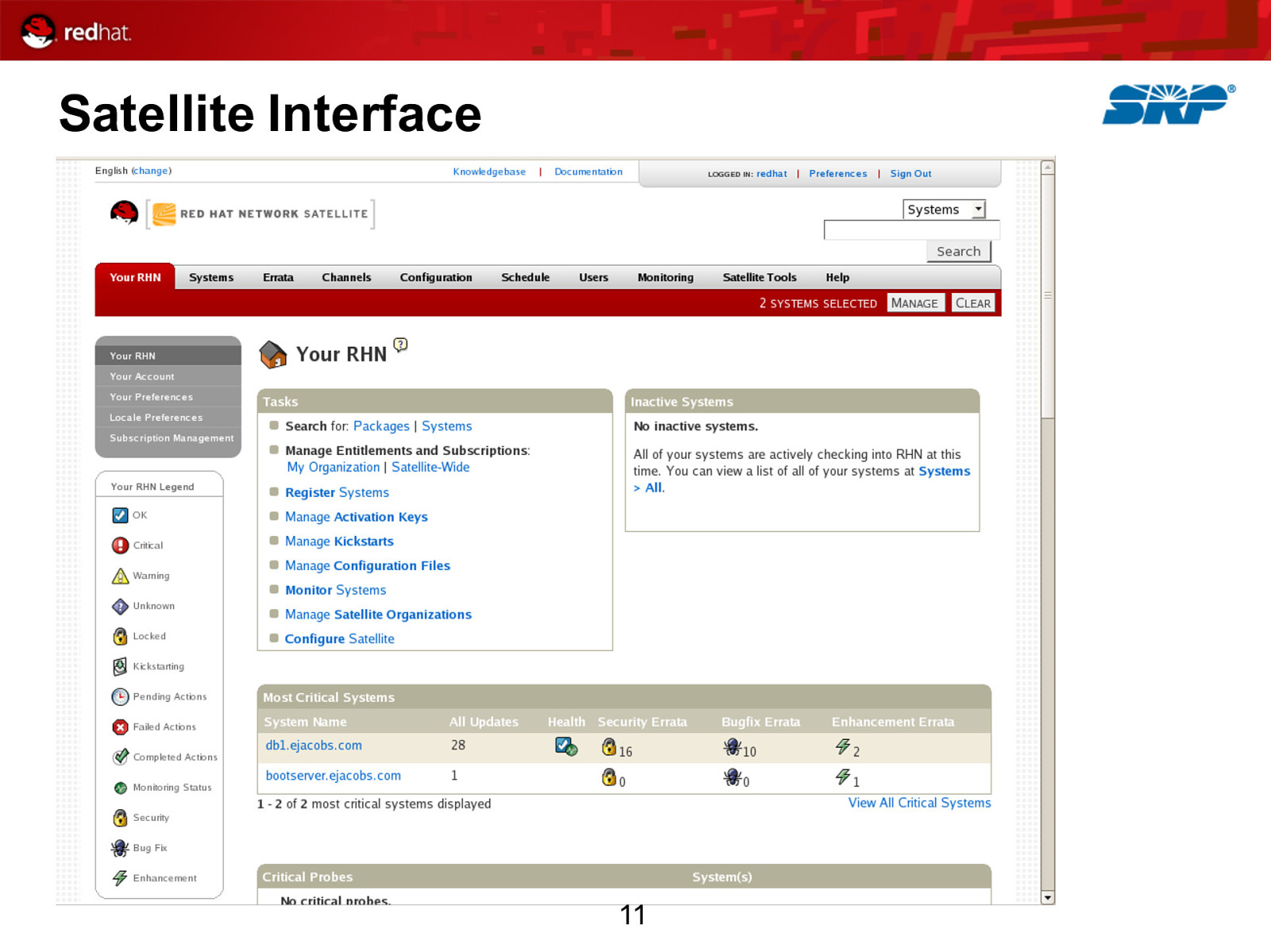
Satellite Interface 11
Slide 12

Key Benefits of Satellite: l l Lower administration costs by increasing SA productivity via automation - Increase number of systems in environment without adding administrators
Time savings let administrators focus on higher value activities.
Allow junior level system administrators perform tasks of senior level administrators, without fear of mistakes or excessive hand holding Reduced system life cycle costs - Lowers deployment, configuration, and management costs
Standardized machine configurations mean lower administration costs
Satellite is the piece needed to make Linux deployable, scalable, manageable, consistent 12
Slide 13

Polling Question l Q: Are you running Linux on the mainframe or do you intend to? l Answers: - Yes
No 13
Slide 14

Salt River Project (SRP) l l l One of Arizona’s largest utilities providers, Salt River Project (SRP) has delivered low-cost, reliable power and water to Arizona customers for over 100 years. SRP includes two entities: the Salt River Project Agricultural Improvement and Power District, a political subdivision of the state of Arizona, and the Salt River Valley Water Users’ Association, a private corporation. The District provides electricity to more than 935,000 retail customers in the greater Phoenix metropolitan area. It operates or participates in 11 major power plants and numerous other generating stations, including thermal, nuclear, natural gas, and hydroelectric sources. The mission of SRP is to deliver ever-improving contributions to the people it serves through the provision of low-cost, reliable water and power, and community programs, to ensure the vitality of the Salt River Valley. 14
Slide 15

Salt River Project FAST FACTS l Industry: Utilities, Government l Geography: Arizona Challenge: which utilization Searched for a replacement for proprietary UNIX software could provide greater flexibility, manageability, and opportunities l l Migration Path: HP-UX to Red Hat Enterprise Linux l Software: Red Hat Enterprise Linux, Red Hat Network Satellite l Hardware: IBM System z Mainframe and HP ProLiant Blades l Benefits: HP Experienced cost savings, boosted performance, stable and reliable management, consolidation, and valuable technical support after migrating to Red Hat Enterprise Linux on IBM System z and ProLiant Blades 15
Slide 16

The Problem l l l RHEL/Linux started small in use but grew (sound familiar?) SRP had been testing Linux in-house for approximately three years, but didn’t have any Linux solutions in production environments. In 2006, SRP upgraded its System z Mainframe. - l Our HP RISC hardware was nearing EOL. - l Prompted an accelerated investigation into running Linux on the IFL. A project was already in place evaluating staying on UNIX or transitioning to Linux. Server sprawl in our Windows environment was a serious problem we had to offer a better solution with Linux or UNIX. 16
Slide 17
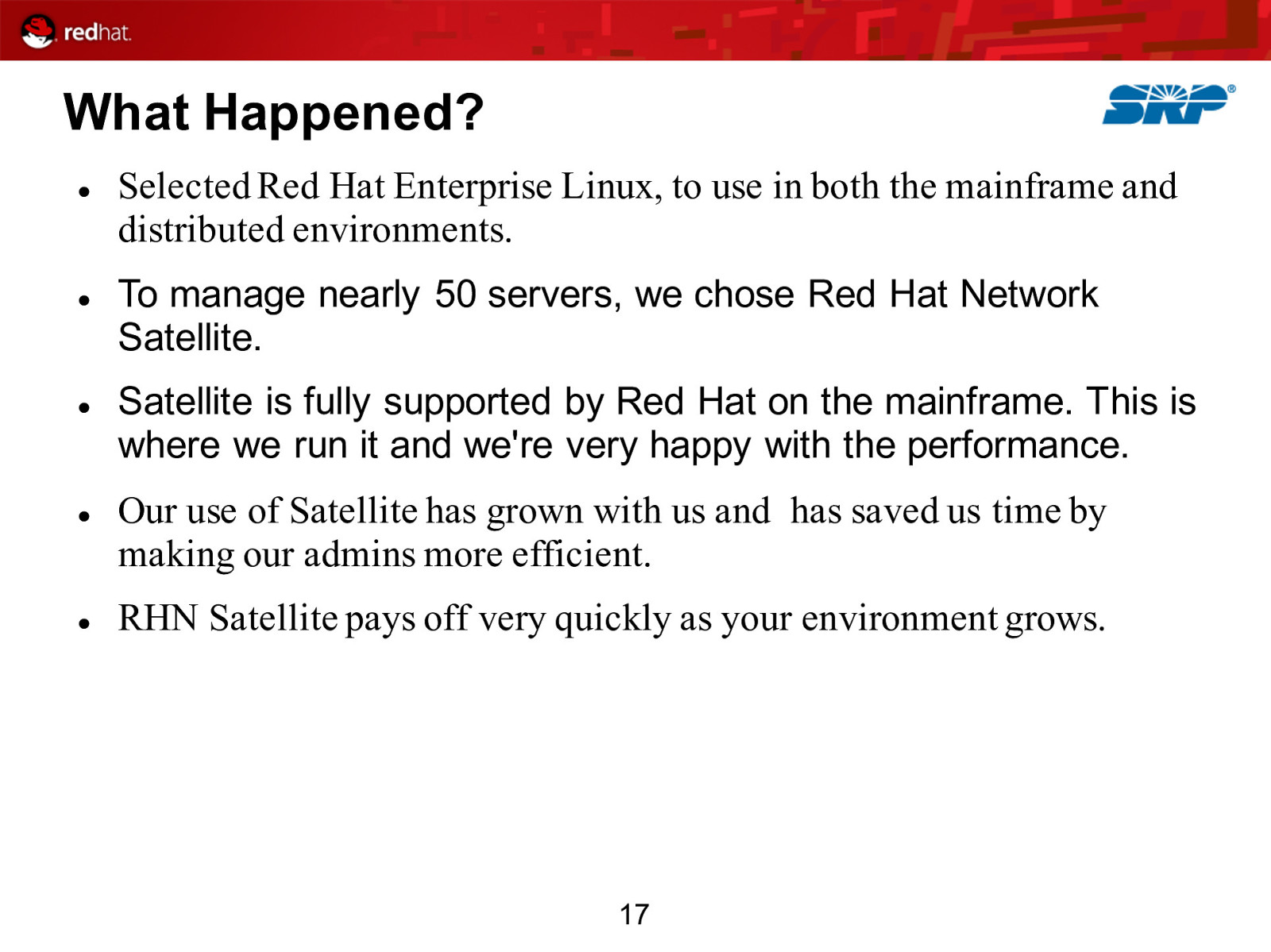
What Happened? l l l l l Selected Red Hat Enterprise Linux, to use in both the mainframe and distributed environments. To manage nearly 50 servers, we chose Red Hat Network Satellite. Satellite is fully supported by Red Hat on the mainframe. This is where we run it and we’re very happy with the performance. Our use of Satellite has grown with us and has saved us time by making our admins more efficient. RHN Satellite pays off very quickly as your environment grows. 17
Slide 18
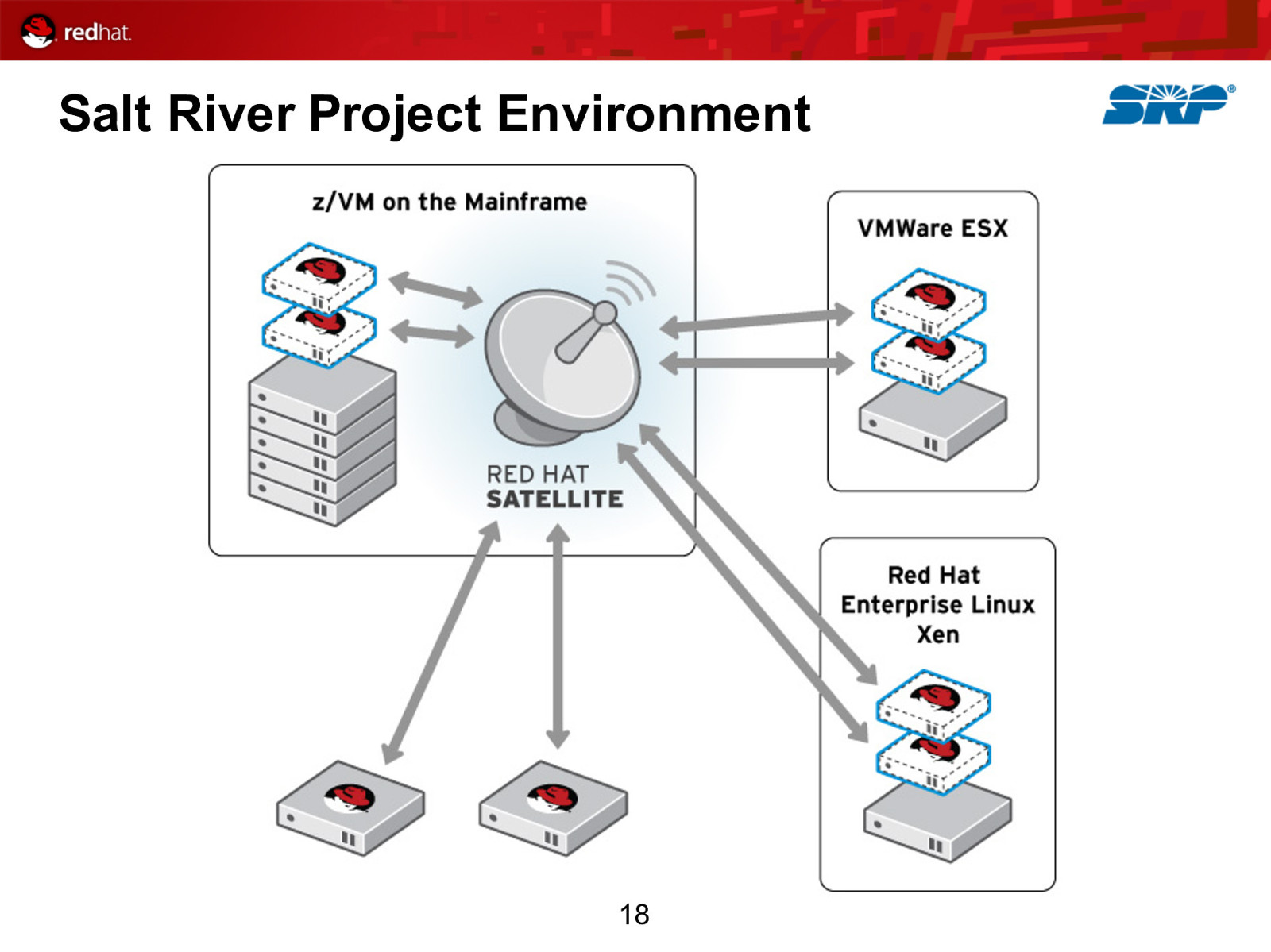
Salt River Project Environment 18
Slide 19

Slide 20

Slide 21
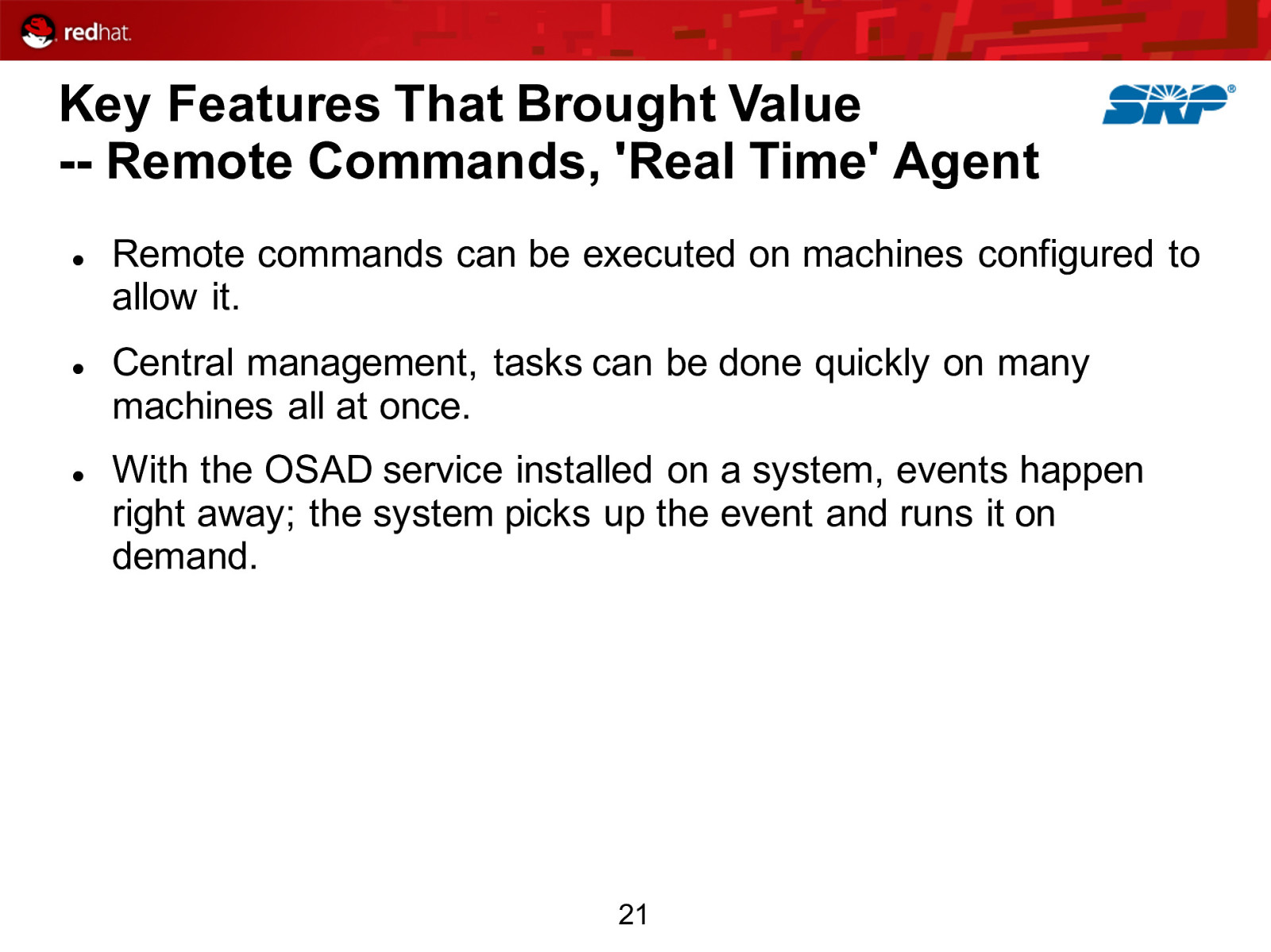
Key Features That Brought Value — Remote Commands, ‘Real Time’ Agent l l l Remote commands can be executed on machines configured to allow it. Central management, tasks can be done quickly on many machines all at once. With the OSAD service installed on a system, events happen right away; the system picks up the event and runs it on demand. 21
Slide 22

Key Features That Brought Value — Inventory l Satellite keeps detailed information on systems - Mac addresses, hardware details, etc.
User specified information (location, notes, etc). l l API available to access (or write) this info.
Fully searchable, can select machines to manage based on searches of system information.
Much faster than HP iLO for querying hardware info. Satellite keeps track of packages on systems - Allows us to do searches for specific packages to see if they’re installed on a system or group of systems.
Package synchronization between systems. Critical for clusters. 22
Slide 23

Key Features That Brought Value — Support l 24/7 Premium Support standard with RHN Satellite l Training Courses available l Professional Services available l Web support is convenient but use phone support for timesensitive, critical issues. - Phone support connects you to an RHCE. 23
Slide 24

Results After Deploying Satellite l l l l l A kickstart & management environment that is simple, reliable, and verifiable. - New systems deployed over twice as fast.
Deploying system changes (files, rpms) 3-5x faster (minutes). Greater system uptime and availability due to fewer human errors. Leverages the benefits of running on the mainframe. A single administrator can make a change on hundreds of machines in minutes, and know the results immediately. Automatic logging of changes allows administrators to quickly and eaisly discover changes previously made by other administrators to a given system. 24
Slide 25

Summary l Deploy new systems faster and easier - l l l Satellite Provisioning makes it much easier to roll out new systems. Manage more systems - Satellite is built to handle thousands of managed systems.
Satellite uses an intuitive web GUI that makes it easy to work with groups of systems. Reduce errors - Centralized configuration file management reduces the opportunity for errors or inconsistencies.
Less human errors = greater system uptime. Next Step - Evaluate Satellite - Contact your Red Hat Account Executive to evaluate Satellite in your Environment. 25
Slide 26

Questions 26